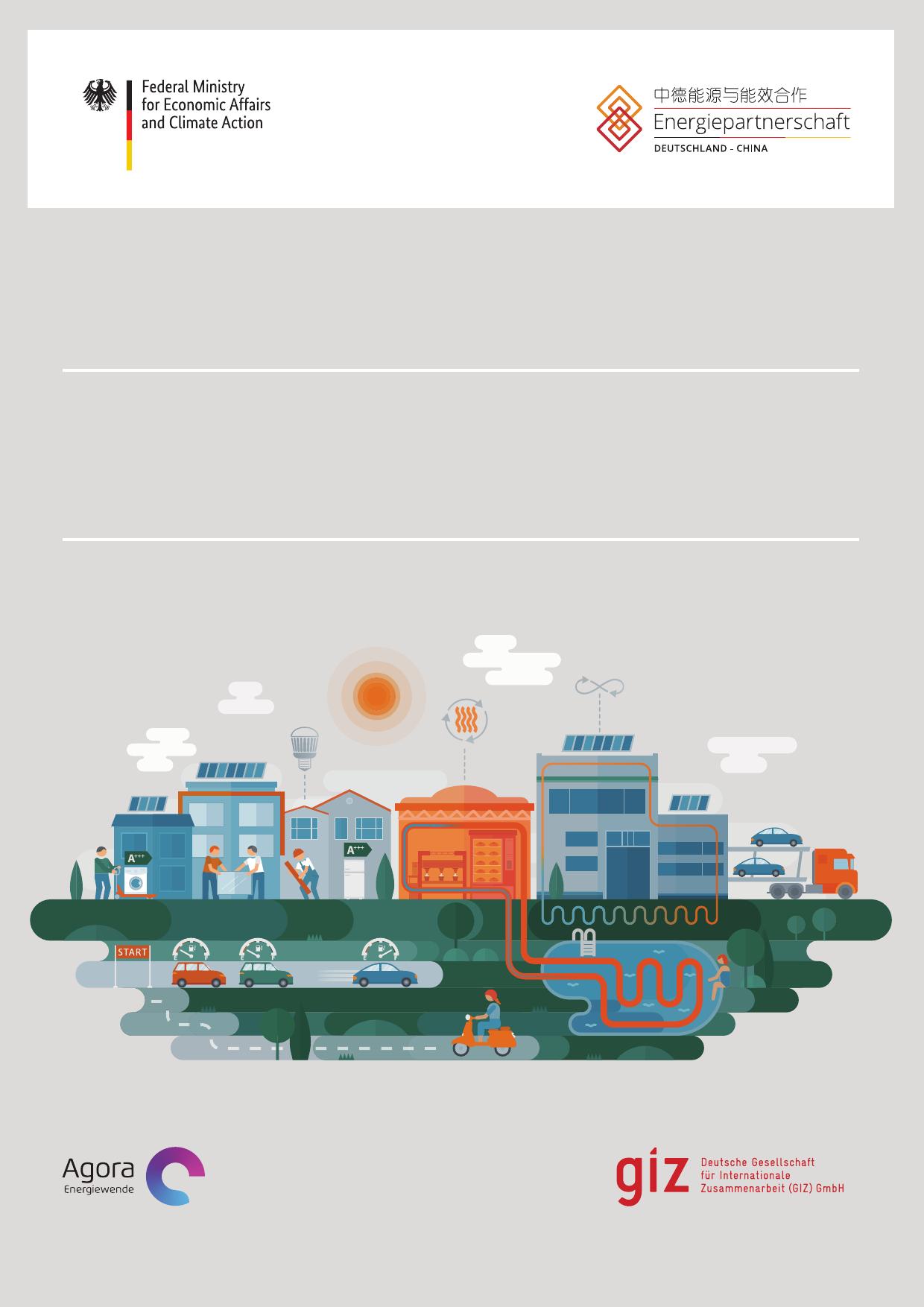ምิൠሞዐࡔڦമৠतሞ߾ᄽྃ༐ዐڦፕᆩProspectsofRenewableHydrogeninChinaandItsRoleinIndustrialDecarbonizationTheanalysis“ProspectsofrenewablehydrogeninChinaanditsroleinindustrialdecarbonization”ispublishedbyAgoraEnergiewendeintheframeworkoftheSino-GermanyEnergyTransitionProject.TheprojectissupportedbytheGermanFederalMinistryforEconomicAairsandClimateAction(BMWK)andtheChineseNationalEnergyAdministrationintheframeworkofSino-GermanEnergyPartnership.TheDeutscheGesellschaftfürInternationaleZusammernarbeit(GIZ)GmbHleadstheprojectimplementationincooperationwithAgoraEnergiewendeandtheGermanEnergyAgency(dena).ThisanalysisprovidesanoverviewofthestatusquoofrenewablehydrogenproductioninChina,illustratesitspotentialinindustrialdecarbonizationandcomparesthenationalhydrogenstrategiesofGermanyandChina,aimingtodrawenvironmentallysoundandpoliticallyplausibleadvicesinsupportofbuildingarenewablehydrogenvaluechaininChina.■ProjectManagementChristophBoth,GIZ■ResearchManagementIsadoraWangisadora.wang@agora-energy.org■AuthorsKevinJianjunTu,IsadoraWang■AcknowledgementsTheauthorswouldliketothankMatthiasDeutsch,RunZhang-Class,AndersHove,FabianBarrera,XueqianChen,YanmingWanfortheirinsightfulcomments.ThispaperandresearchbehinditwouldnothavebeenpossiblewithoutthesupportprovidedbytheDeutscheGesellschaftfürInternationaleZusammenarbeit(GIZ)GmbHaswellasAgora’sclosecollaborationwithChinaEV100HydrogenCenteramongstotherkeystakeholders.Ofcourse,mistakesifanyaretheauthors’own.■GraphicsBMWK/CoverKevinJianjunTu(p.4)Unsplash/YusenSun(p.13)Unsplash/PickledStardust(p.16)Unsplash/JoseCastillo(p.22)Unsplash/MarkKonig(p.25)ImprintProspectsofRenewableHydrogeninChinaandItsRoleinIndustrialDecarbonization2ExecutiveSummary执行摘要作为全球最大的氢能生产和消费国,中国每年生产氢气高达3,400万吨左右。中国当前制氢路线以煤为主(72%),并有约450万吨未被有效利用,未来可用于工业脱碳等领域,并能为可再生氢产业链的建设打好基础。中国的电解制氢仍处于起步阶段,各地规划的32个可再生氢气试点项目设计年度总产能已超过29.7万吨。推动中国可再生氢产业链发展重在下游应用端。然而,氢作为一种能源载体,在转换过程中伴随较大的能量损耗。因此,如何尽快明确最适合可再生氢应用的场景,即“无悔”选项,已成为当务之急。氢能有望成为大规模、长时间储能的解决方案,为风电、光伏等间歇性可再生能源发电提供托底保障。可再生氢也有望助力排放密集型工业流程的深度脱碳。在上述应用场景中,可再生氢能够有效替代化石燃料作为能源载体和生产原料的双重角色。以钢铁行业为例,氢直接还原铁可以大幅降低焦炭消费。在海运和长途飞行领域,直接通过电气化减少碳排放不但效率低下而且成本高昂,采用可再生氢被广泛认为是实现净零排放的不二法门。中国和德国同为制造业大国,都设置了在本世纪中叶实现净零排放的气候目标,因此在清洁能源转型领域面临着诸多共同挑战。尽管俄乌冲突全面爆发导致了全球范围的能源安全焦虑,德国仍在为实现2045年气候中性目标而加速布局可再生氢能政策和产业,以有效支撑本国的清洁能源转型进程。作为极具气候雄心的发达经济体,德国在氢能经济领域的经验和教训可以帮助中国培育本国处于起步阶段的可再生氢产业链。本文从氢能治理结构、提高氢能经济可行性措施和促进氢能应用等方面剖析了德国2020年6月发布的《国家氢能战略》。结合中国2021年3月发布的《氢能产业发展中长期规划(2021-2035年)》以及电动汽车在中国的发展历程,作者基于中国具体国情提出了以下有针对性的政策建议:●�为更好更快建立工业化规模的低碳氢供应链,中国应在充分利用本国现有化石燃料制氢产能的同时激励可再生氢产能的持续增长。基于中国在电动车发展助力交通行业减排过程中所取得的经验,在氢能产业链规模化之前,扩大氢能的下游需求与上游的低碳生产应该区分对待。扩大可再生氢产能应与鼓励氢能大规模应用同时推进,从而在氢能产业链的上、下游之间产生正向激励效应。另一方面,本世纪初以来全国燃煤发电装机的快速扩张已提前锁定了巨量煤炭需求,中国应以此为鉴,尽量避免进一步扩大现有化石燃料制氢产能规模。●�氢能管制应更多侧重其能源属性。目前,中国仍将氢气作为危险化学品进行标识和监管,对其能源属性没有予以充分考量和反映。对氢能的危化品定位在生产选址、道路运输、市场准入、终端应用以及标准化等方面带来了一系列重大挑战。中国未来是否能够更加合理地对氢能进行定位是实现氢能规模经济性的重要先决条件。●�可再生氢在工业深度脱碳中的作用应被优先考虑,并重点聚焦钢铁、石油化工和煤化工产业。鉴于可再生氢在重工业应用中的巨大潜力,工业脱碳应成为中国实现可再生氢供应链规模经济性的重点领域。除了尽快将排放密集型的工业行业纳入全国碳排放交易体系,还应考虑将德国乃至欧洲的创新政策和金融政策工具针对中国国情进行定制和试点,尤其是绿钢的政府采购、碳差价合约和气候友好型原材料的需求配额。●�为更好促进可再生氢在中国的发展,应建立氢能部际协调机制,并最好由国务院直接领导。否则,氢能治理的职责如果长期分散在在不同部委之间,将会阻碍氢能的长足发展,并使中国错失先机。建议由该高层协调机制主导对建设跨省氢能管道这一无悔基础设施的必要性和规划展开调查研究,以积极应对中国氢气生产、消费地理错配的挑战。●�中央和地方政府补贴氢能发展时,应在制度设计层面防范“骗补”乱象并促进公平竞争。根据以往补贴政策实施过程的经验教训——尤其是电动汽车领域——中国氢能监管框架应重视制约与平衡,并纳入多重监督机制。●�为了缩小与发达经济体在氢能核心技术领域的差距,中国应考虑为包括跨国公司与本土企业在内的市场主体营造更加公平的竞争环境。如果能够大幅加强知识产权保护、积极消除市场准入壁垒,中国将能更好地深化与发达经济体在可再生氢领域的国际合作,并吸引欧盟特别是德国公司来华展开互利双赢的技术合作和商业投资。ProspectsofRenewableHydrogeninChinaandItsRoleinIndustrialDecarbonization3◆1Statusquo:hydrogenproductioninChinadominatedbyfossilfuels11.1Coal-relianthydrogenproductioninChina21.2SignificantpotentialtoscaleuphydrogenutilizationinChina31.3RationaleforChina’srenewablehydrogeneconomy51.3.1Versatilehydrogen51.3.2Sectorcouplingviarenewablehydrogen51.3.3Carbonintensityofhydrogentobereducedviarenewables-poweredwaterelectrolysis71.4RenewablehydrogeninChina81.4.1RenewablehydrogenproductionconcentratesinNorthChina81.4.2Mismatchbetweensupplyanddemandofrenewablehydrogen9◆2No-regret:hydrogen'sroleinChina'sindustrialdecarbonization102.1Renewablehydrogenapplicationscenarios112.2No-regretutilizationofrenewablehydrogeninindustrialprocesses12◆3Germany'snationalhydrogenstrategyandimplicationsforChina133.1Germanhydrogenpolicytoolsanddedicatedgovernance143.1.1Structuredgovernanceandthepolicyenvironment143.1.2Makingrenewablehydrogeneconomicallyviable153.1.3Promotinghydrogenapplicationsinkeydownstreamsectors153.1.4ImplicationsofEUCarbonBoarderAdjustmentMechanism(CBAM)andClimateClub163.2China’snationalstrategyforhydrogen173.2.1Improvedcoordinationofhydrogenvaluechaingovernance173.2.2Detailedsupportingpoliciesyettobepromulgated183.2.3Theneedtoemphasizehydrogen’sroleinindustrialdecarbonization18◆4ExperienceandlessonsofChina'sEVprogram194.1SeparationofupstreampowerproductionanddownstreamEVdeployment204.2Avoidingfraudandpromotingfaircompetition21◆5Policyrecommendations22◆AnnexAAlistofrenewablehydrogenprojectsinChina24◆AnnexBAlistofselectedkeystakeholdersforhydrogengovernanceinChina28◆References29Content1Statusquo:hydrogenproductioninChinadominatedbyfossilfuels2ProspectsofRenewableHydrogeninChinaandItsRoleinIndustrialDecarbonization1.1Coal-relianthydrogenproductioninChinaExceptforrarecircumstances,molecularhydrogendoesnotoccurnaturallyintheearth’scrust,butoftencombineswithoxygen,carbon,nitrogenorotherat-omstoformcompoundssuchaswater(H2O),hydro-carbons(CxHy)orbiomass(CxHyOzNa).Therefore,technologiestoproducehydrogengasatscalearees-sentiallydifferentmanufacturingroutesofseparatinghydrogenfromitsvariouscompounds.Whatmakesthehydrogeneconomy—ahypotheticfuturesystemofdeliveringenergyandrawmaterialsthroughtheuseofhydrogen—challengingisthefactthatthehydro-genvaluechainincludingproduction,transportation,storageandendusesmaynotalwayscomewithclearboundaries.Inotherwords,hydrogenproductionandconsumptionoftenoccurinthesameindustrialfacili-ties,andhydrogenprosumersincludebutarenotnec-essarilylimitedtomanufacturersofcoke,ammonia,methanol,chlor-alkali,petrochemicalsandtheChi-nesemoderncoalchemicalssuchascoal-to-oil,coal-to-gas,coal-to-olefin,andcoal-to-ethyleneglycol.Hydrogenmadewithenergyderivedfromrenewablesourcesistypicallyknownas“renewablehydrogen”intheinternationalcontext,especiallyintheEuropeanUnion(EU).1Atpresent,Chinalacksanationalstan-dardforrenewablehydrogen,buttheEUdefinitioniswidelyaccepted.Withmorecountriesadoptingna-tionalhydrogenstrategies,andrisingbusinessenthu-siasmtowardsdemonstrationprojects,theconceptofarenewablehydrogeneconomyhasgainedworldwidemomentum.However,todate,96%ofglobalhydrogensupplystilloriginatesfromfossilfuel-basedproduc-tionroutessuchassteammethanereformation(SMR),coalgasificationandcokemanufacturing.Toacceleratetheglobalcleanenergytransitionandachieveclimateneutralitybymid-century,thereisaconsensusthattheworldmustdrasticallycurbfossilfuelconsumption.Althoughhydrogenhasbeenin-dispensableintheenergyandchemicalindustriesfordecades,theenvironmentalfootprintoftheexistinghydrogenvaluechainisunsustainable.Hence,inju-risdictionswithnet-zeroemissiongoalssuchastheEUandChina,electrolytichydrogenproductionpow-eredbyrenewableenergyhasdrawnattentionasaversatileandsustainableenergyvectorwithpotentialtohelpdecarbonizetheenergyeconomy,especiallyincarbon-intensiveindustrialsectors.AsChina’ssecondlargesttradingpartnerandanad-vancedeconomywithambitiousclimateaspiration,theEUingeneralandGermanyinparticularplayaleadershiproleinconceptualizingandnurturingtheglobaldevelopmentofarenewablehydrogeneconomy.Naturally,Europeanpracticesandlessons,especiallythosefromGermany,areparticularlyrelevanttopoli-cymakersinChina,thelargesthydrogenproducerandconsumerintheworld.Figure1.Hydrogenproductionmixbysourcein2020:ChinaversustheworldWord(by-productseparated)China(by-productseparated)Word(by-source)China(by-source)72%18%65%19%14%48%14%60%10%30%4%4%1%20%21%CoalNaturalgasOilElectrolysisDedicatedelectrolysisBy-productSource:IRENA,IEA,andtheauthors’ownestimation.1�Source:TheEuropeanCommission,accessedon12March2022athttps://energy.ec.europa.eu/topics/energy-system-integration/hydrogen_en.3ProspectsofRenewableHydrogeninChinaandItsRoleinIndustrialDecarbonizationOnthesupplyside,nationalhydrogenproductionacrossChinaisestimatedtoreach34.1milliontons(Mt)in2020,aslight2%year-over-year(YOY)up-tickfrom33.4Mtin2019.HydrogenmanufacturinginChinaisdominatedbyfossilfuels,with96%ofsup-plycomingfromcoal,naturalgasoroil.Electrolysisincludingchlor-alkaliby-productionandwaterelec-trolysisonlyaccountfortheremaining4%ofnationaloutput.Coal-basedhydrogenproductionranksthefirstwith72%ofmarketsharelargelyduetodomes-ticallyabundantandaffordablecoalresourcesaswellasChinesegovernment’slargelysupportiveattitudetowardsthecoalchemicalindustry,especiallyatthelocalgovernmentlevel(Figure1).Figure2.Chinahydrogenflow2020Methanol8.0MtAmmonia10.6MtHeating5.0MtRefining3.0MtWaste4.5MtOthers3.2MtCoalgasification14.4MtCokemanufacturing10.4MtOil3.3MtNaturalgas4.7MtChlor-alkali1.0MtWaterelectrolysis0.5MtProductionConsumption1.2SignificantpotentialtoscaleuphydrogenutilizationinChinaAmongcoal-derivedhydrogenmethods,coalgasifi-cationoutweighsby-producthydrogenproductionofbothcokeandchlor-alkalimanufacturing,withtheiroutputstandingat14.4Mt,10.4Mt,and1.0Mtrespec-tivelyin2020(Figure2).Currently,electrolytichydrogenproductioninChinaisstillatitsinfantstage,comprisingofabout510thou-sandtonsperyear(kt/year)outputfromrenewablehydrogendemonstrationprojects(seeAnnexA:AListofrenewablehydrogenprojectsinChina)and925kt/yearsupplyfromchlor-alkaliby-production.Conse-quently,waterelectrolysisbyrenewablepower(re-newablehydrogen)isevenmorenegligible.Onthedemandside,ammoniamanufacturingisthelargesthydrogenconsumingindustryinChina,followedbymethanolsynthesis,petroleumrefin-ing,chlor-alkaliandotherindustrialprocesseswithby-producthydrogen,whichutilizehydrogenon-siteforeitherprocessheatorasafeedstock.The4.5Mt/yeargapbetweennationalhydrogenproductionandsector-specificconsumptionrepresentshydrogenwasteflows.Anumberoffactorsaccountforthis.Cokeovengasesproducedincokefurnacesandsynthesisgasesgeneratedincoalgasifiersareamixtureofhy-drogen,methane,carbonmonoxide(CO)andotherimpurities.BeforeChinaintroducedthedemonstrationcityclustersforhydrogenfuelcellvehicles,itusedtobeeconomicallyunattractivetoseparatehydrogenforuseratherthanforon-sitecombustiontoheatthecokeovens(5.0Mt)orasfeedstockgasesformethanolsynthesis(1.0Mt/year)andammoniamanufacturing4ProspectsofRenewableHydrogeninChinaandItsRoleinIndustrialDecarbonization2�Exchangerate:€1=¥7.23.(0.3Mt/year),orsimplybeingventedaswastedis-charge.Meanwhile,another0.4Mt/yearofby-producthydrogeniswastedinvariouschlor-alkalimanufac-turingfacilitiesduetoalackofappropriateplanningandprocessoptimization.Asaresult,greatpotentialexiststofurtherimprovematerialefficiencythrough-outtheChinesehydrogensupplychainintheyearstocome.Consideringthemagnitudeandcompositionofhy-drogenproductioninChina,itisnaturaltokickoffthecountry’sfledglinghydrogeneconomybyfocusingonutilizationofby-producthydrogen.Inthisregard,about1.3Mt/yearofby-producthydrogenfromcokemanufacturinghasbeenturnedintomethanoloram-monia,drivenlargelybyChina’sincreasinglystringentenvironmentalprotectionandindustrialefficiencystandards.In2021,theChinesecentralgovernmentapprovedfivedemonstrationcityclusterscenteredinBeijing,Shanghai,Guangdong,HenanandHebeiProvinces.Thisfour-yearpilotprogramwasdesignedtopromotecommercialisationofkeytechnologiesrelatedtofuelcellelectricvehicles(FCEV),toestablishanFCEVsup-plychain,toexploreeffectiveFCEVbusinessmodels,andtoimproveregulationandindustrialstandards.Thecentralgovernment’sstrongsupportforFCEVcommercializationhassentaclearsignaltothebusinesscommunity,whichhasstartedtorampupindustrialby-producthydrogenutilization.Accord-ingtoLiu&Shi(2021),theunitproductioncostofindustrialby-producthydrogeninChinaisat¥6.2-22.3/kg(€0.9-3.1/kg),muchlowerthanthatviawaterelectrolysisat¥22.9-51.5/kg(€3.2-7.1/kg)(Liuetal.,2022).2ThoughrenewablehydrogensupplyisnotwidelyavailableacrossChina,itsapplicationsinFCEVscouldhelpencouragehydrogenutilizationinselectedcityclusters.Asaresult,the5.0Mt/yearofhydrogenthatwereburnedon-siteforheatingandthe4.5Mt/yearofwastehydrogenflowcouldbetappedfirstformoreutilizationorrecovery.Obsoleteregulationsareonemajorbarrierthatpre-ventsChinafromdevelopinganinternationallycom-petitivehydrogeneconomy.Governmentregulationsrequirelabelingandhandlinghydrogenasahazardouschemical,asdistinctfromothermajorenergyfuels.Thisspecificpolicyhasimposedtremendouschal-lengesintermsofsitingproductionfacilities,trans-portationespeciallyviaroads,qualificationofnewindustrialentrants,applicationscenariosaswellasstandardization.Recommendationshavebeenmadebyprominentde-cisionmakersincludingformerministerofscienceandtechnology,Dr.WanGang,whosuggestedinNo-vember2018thathydrogenshouldberegulatedinac-cordancewithitsenergynature,similarasgasolineordiesel,sothathydrogenrefuellingstationscouldenjoygreaterflexibilityintermsofsiting.Thisrecommen-dationhasbeennotedinsubsequentgovernmentpoli-cydocuments.Forinstance,thedraftEnergyLawpub-lishedinApril2020andthe2021GovernmentWorkReportbothcategorizehydrogenasanenergycarrier.TheChinesecentralgovernment’ssupportforestab-lishingahydrogensupplychainwasfurtherunder-pinnedinMarch2022bytheMedium-andLong-termPlanfortheDevelopmentoftheHydrogenEnergyIn-dustry(2021-2035),theequivalentofChina’snation-alhydrogenstrategy.Justonemonthlater,the14thFive-Year-Plan(FYP)forNationalProductionSafetyoutlinedtherequirementofspeedingupproductionsafetystandardsforemergingindustriesincludinghy-drogen.InJune2022,the14thFYPforRenewableEn-ergyDevelopmentfeaturesasectionentitledPromot-ingLarge-scaleUtilizationofHydrogenProductionbyRenewableEnergy,whichmentionssectorssuchaschemicals,coalminingandtransportation.Lastbutnotleast,tofosteranintegratedhydrogensupplychainhasbeenincorporatedintotheStateCouncil’sOpinionsonCompletely,AccuratelyandComprehensivelyImplementingtheNewDevelopmentConceptandAccomplishingCarbonPeakingandCar-bonNeutrality,whichistheoverarching“1”ofChina’s“1+N”policyframeworkforachievingitsDual-CarbonGoals.FollowingthereleaseofChina’sMedium-andLong-termHydrogenPlanon23March2022,moredetailed“N’s”areexpectedtopromotethedevelop-mentofhydrogenproduction,storage,transportationandutilization,especiallyincarbon-intensiveindus-trialsectorssuchasinthesteelandchemicalindus-tries.5ProspectsofRenewableHydrogeninChinaandItsRoleinIndustrialDecarbonizationAtthe75thUnitedNationsGeneralAssemblyon22September2020,Chinaannouncedplanstopeakna-tionalcarbonemissionsbefore2030andachievecar-bonneutralitybefore2060,acommitmentknowninChineseasthedualcarbongoals.Sincetheannounce-ment,expertshavedebatedpotentialpathwaystocompletelydecarbonizetheenergyeconomyingeneralandindustrialsectorsinparticular.Hydrogenservesasapotentiallycarbon-freeenergycarrierandindus-trialfeedstockandcouldtherebyassistChina’stran-sitionfromahighlyfossilfuel-relianteconomytoanincreasinglyrenewables-dominatedsystem.1.3.1VersatilehydrogenHydrogenprovidesapotentialsolutionforlarge-scale,long-durationenergystoragethatcouldcompensatethevariabilityofrenewableenergygeneration,espe-ciallywindandphotovoltaicpower.Comparedwithothertechnologiesincludingbatteries,compressedairandflywheels,hydrogeniswellpositionedtoen-ablelong-durationstorage,fromweekstomonths,andisthemostpromisingemergingtechnologytobedeployedatscaleforlongdurationstorage.Since1972,theTeessidesaltfieldintheUKhasbeenstoringalmostpurehydrogen(95%H2,3–4%CO2)inthreeshallowsaltcaverns(atadepthofaround400me-ters),eachofwhichhasacapacityofaround70,000cubicmeters(m3)ofhydrogenat45bar,3or25GWh.4TheexplorationofutilizingrenewablehydrogenforseasonalenergystorageishighlightedinChina’shy-drogenplanfor2021-2035.Hydrogenalsohasthepotentialhelpdecarbonizecar-bon-intensiveindustrialsectorswherefossilfuelisutilisedbothasanenergycarrierandasafeedstock.Renewablehydrogenisanemergingcarbon-neutralreducingagentinironandsteelmanufacturing,andthushaspotentialtoeliminateotherwisehard-to-abateCO2emissionsfromsteelmakinginChina,whichaccountsformorethanhalfofglobalsteeloutputandabout15%ofChina’snationalCO2emissions.Anum-berofChina’sleadingsteelenterprises,suchasHe-beiIronandSteel(HBIS),BaowuandJianlong,begunexperimentingwithhydrogenmetallurgy,aimingtoexplorepotentiallowcarbonandnet-zerosolutionswithrenewablehydrogen.Renewablehydrogenalsopromotessectorcouplingbetweenthechemicalindus-tryandrenewablepower,leadingtolow-carbonsub-stitutionoffossilfuel-basedhydrogeninammonia,methanolandotherchemicalmanufacturingfields.Hydrogenalsohasapplicationsinfieldswheredirectelectrificationmightrepresentaninefficientorhigh-costpathwaytonet-zero,suchasinthefieldsoflong-haulheavy-dutytrucking,maritimeshippingandaviation.Inthesesectors,renewablehydrogenanditsderivatives(suchasgreenammonia,greenmethanol)mayserveasthelastresortofindustrialdecarboniza-tiononceallotheroptionsareexhausted.1.3.2SectorcouplingviarenewablehydrogenSectorcouplingisdefinedastheconnectionofatleasttwodifferentsectorsviasubstitutionofnon-renew-ableactivitieswithrenewablealternativestoestablishfullyrenewableenergysystems.5Someadvantagesofsectorcouplingincludeincreasedflexibility,en-hancedstorage,anddistributionopportunitiestouserenewableenergy,aswellasreliability.Inenergytransition-relateddiscourse,sectorcouplingimpliesmakingrenewablepowerthedefaultformofenergyinenergyconsumingsectorswhereverpossible.Becauseweather-dependantrenewablesarenotalwaysavail-ablewhenenergyisneeded,andasthemarketshareofwindandsolaringlobalelectricitygenerationgrowingatdoubledigits,6energystorageandpowerbalanc-ingbecomenotonlyincreasinglyprominenttechnicalchallengesbutalsobusinessopportunities.Sectorcouplingcouldbeespeciallybeneficialinthefollowingscenarios:powercouldbeusedtoheatlargeamountsofwater(power-to-heat,PtH),electrifyingtheheatingsector.Duringperiodsofpeakrenewablepoweroutput,excesselectricitycouldbeutilizedtoproducehydrogenorsyntheticgases(power-to-gas,1.3RationaleforChina’srenewablehydrogeneconomy3�Source:AleksandraMałachowskaetal.(2022),“HydrogenStorageinGeologicalFormations—ThePotentialofSaltCaverns”Energies2022,15:5038.4�Source:JohnWilliamsetal.,“TheoreticalcapacityforundergroundhydrogenstorageinUKsaltcaverns,”BritishGeologicalSurvey,accessedon10January2022athttps://ukccsrc.ac.uk/wp-content/uploads/2020/05/John-Williams_CCS-and-Hydrogen.pdf.5�CaledoniaT.C.Trappetal.,“Sectorcouplingandbusinessmodelstowardssustainability:Thecaseofthehydrogenvehicleindustry,”March2022.6�Reference:JoelJaeger,“ExplainingtheExponentialGrowthofRenewableEnergy,”WorldResourcesInstitute,September2021.6ProspectsofRenewableHydrogeninChinaandItsRoleinIndustrialDecarbonizationFigure3.SectorcouplingviarenewablehydrogenPtG).Thegasescanthenbeuseddirectlytoproduceelectricityandheatintimesoflowrenewableout-put,orasareducingagentorfeedstockforindustrialsectorssuchassteelmakingandammoniamanufac-turing.Anindirectapplicationoftheabovegasesistofurtherprocessthemtovarioustypesofelectro-fuels(e-fuels)foraviation,maritimeshipping,andlong-haulheavy-dutytrucking.EspeciallyinEurope,en-ergyconversionpathwaysthatutilizeelectricityastheprimaryinputtoproducevariouse-fuels,energyservices,andchemicalsareoftencategorizedasPow-er-to-X(PtX),withtypicalproductsasbelow:●Hydrogen●�E-ammonia●�E-methanol●�E-gasoline●�E-LPG(liquifiedpetroleumgas)●�E-jetfuel●�E-dieselIn2021,renewablesaccountfor30%ofChina’spowergeneration,andChinaplanstoincreasethisto33%by2025.ThoughChina’s14thFYPtargetsforrenewablesarewidelyconsideredconservative,thegrowingshareofrenewablesinChina’spowermixenablesrenewablehydrogenserveasanenergycarriertosupplementingelectricityinsectorcouplingandnet-zerodecarbon-ization,especiallyintransportandenergy-intensiveheavyindustry.7ProspectsofRenewableHydrogeninChinaandItsRoleinIndustrialDecarbonization1.3.3Carbonintensityofhydrogentobereducedviarenewables-poweredwaterelectrolysisAllthecarbonabatementbenefitsrelatedtorenew-ablehydrogenarebasedonthepremisethatitispro-ducedviaelectrolysiswithrenewables.Bycomparison,CO2emissionsdischargedfromChina’ssizablefossilfuel-basedhydrogenproductionroutesaresignifi-cantlyhigher(Figure3).Therefore,replacingfossilfuel-basedhydrogenwithrenewablehydrogeninatimelyfashioniscrucialtoeffortstoreduceChina’sindustrialemissions.Toavoidunderminingitsdualcarbongoalsandlock-inginemissions,Chinaneedstoensurethatgreenfieldhydrogencapacityadditionsarebasedonrenewables.However,Chinacurrentlylacksconcretesupportingpolicies.Eventhechemicalsectorlacksarequirementthatnewcapacitytobebasedonlow-carbonroutes.Thoughrenewablehydrogenhasyettoreachcostpar-itywithcoal-basedhydrogen,itscompetitivenessisexpectedtoimproveovertime,especiallyonceChina’snationalcarbonemissionstradingschemeisenlargedbeyondthepowersector,withthechemicalsectorlikelyamongthenextsectorstofacecarbonpricing.Forcompaniesalongthehydrogensupplychaintoavoidstrandedassetsandlocked-ininvestment,pro-activeplanningandpreparationfortheforthcominggreentransitionisnecessary.Figure4.CO2intensityofhydrogenproductioninChina(kgCO2e/kgH2)38.628.5130.501020304050Coal-firedpowerCoalgasificationNaturalgasRenewablesHydrogenproductionsourceCO2emissions(kgCO2e/kgH2)Source:ChinaHydrogenandFuelCellIndustryHandbook,20208ProspectsofRenewableHydrogeninChinaandItsRoleinIndustrialDecarbonizationFigure5.DistributionofrenewablehydrogenprojectsinChinaBeijingShandongHeilongjiangTibetAutonomousRegionXinjiangJiangxiAnhuiJilinInnerMongoliaGansuNingxiaShanxiShaanxiHebei1project2–5projectsMorethan5projectsZhejiangHenanDisclaimer:ThismapisforillustrativepurposesanddoesnotrepresenttheexpressionofanyopinionofAgora,concerningthelegalstatusorsovereigntyofanycountryorterritory,thedelimitationoffrontiersorboundariesorthenamesofanyterritory,cityorregion.1.4RenewablehydrogeninChinaInSeptember2021,theChinaHydrogenAllianceandtheRockyMountainInstitute(RMI)jointlylaunchedtheRenewableHydrogen100Initiative,settinganambitionofbuilding100gigawatts(GW)ofinstalledrenewablehydrogenproductioncapacityacrossChinaby2030.Supportedbypolicy,state-ownedenterprises(SOEs),privateChinesecompanies,andinternationalcompaniesinChinaareallexpectedtotakeanactivepartinrenewablehydrogenproduction.However,amajorquestionremainsofhowtheregulatoryframe-workmightsupportthistransition.1.4.1RenewablehydrogenproductionconcentratesinNorthChinaIntermsofgeography,asofJuly2022,therewere50renewablehydrogenproductionprojectsareunder-wayacrossChina,concentratedmainlyinNorthChina.(Forfurtherdetail,seeAnnexA:AlistofrenewablehydrogenprojectsinChina.)InnerMongoliaandHebeileadotherprovincessofar,thoughthedriversineachprovincediffer.AsChina’ssecondlargestcoalproducer,andasaprovincewithenormouscleanenergyresources,InnerMongoliahaslongplannedtofosterarenewablehy-drogensupplychain.TheprovincehasChina’slargestinstalledwindcapacity(39.9GW),andthehighestsolarenergypotential,aswellaspossessingabun-dantby-producthydrogenproduction.WuhaiinInnerMongoliabecamethefirstChinesemunicipalgovern-menttoreleasea14thFYPforhydrogendevelopment.Startingfromutilizingby-producthydrogenfromcoalchemicalsandchlor-alkalimanufacturing,Wuhaiaimstoestablishthefirsthydrogen-basedsteel-mak-ingzoneinChinaby2025.InApril2021,itsOrdosCitypublishedaThree-YearActionPlanforHydrogenDevelopment,prioritizingdeploymentofsevenre-newablehydrogenproductionprojects,withaggregatecapacityat42.3kt/year.InJuly2021,theprovincialenergybureaureleasedadrafthydrogenpolicyforpublicconsultation,tar-geting500kt/yearofrenewablehydrogenproduction9ProspectsofRenewableHydrogeninChinaandItsRoleinIndustrialDecarbonizationcapacityandcommercializationofhydrogen-basedsteelmakingandchemicalmanufacturingby2025.InMarch2022,InnerMongolia’s14thFYPonEnergyandOpinionsonPromotingtheHigh-QualityDevelopmentoftheHydrogenIndustryreiteratedtheabovetargetsonrenewablehydrogenproduction,by-producthy-drogenutilizationandhydrogen-basedenergystor-age.InadditiontotheprojectslistedinAnnexA,13otherprojectsareunderdevelopment.ForHebeiprovince,allthenineexistingprojectsarelocatedinZhangjiakou,acityinthenorthwestoftheprovincewherewindenergyresourcesareabundant.180kilometresawayfromBeijingandsiteofwin-tersportsvenues,ZhangjiakoutakesadvantageofitsproximitytoBeijinganditspositionasoneofthethreecompetitionzonesforthe2022BeijingWinterOlympicGames.Renewablehydrogencontributedtoazero-carbonOlympicGamesastheprimaryfuelfordedicatedbuses.Thepreparationofrenewablehydro-genprojectsinZhangjiakoucommencedasearlyas2016withstrongsupportfromthelocalgovernment,state-ownedenterprises(SOEs)andmultinationalcompanies.AmongChina’stherenewablehydrogenproduc-tiondemonstrationprojects,fourareoperational.ThelargestisBaofengEnergy’srenewablehydrogenprojectinNingxiaprovince.With200MWsolarPVcommissionedinApril2021tofeed30MWalkalineelectrolysersinPhaseOne,theprojecthasanannualrenewablehydrogenoutputofabout240millionm3withautilizationrateat46%.ThehydrogenfeedsBaofeng’scoalchemicalfacilitiesforolefinproduc-tion,reducingcoalconsumptionbyabout320ktperyear,ortheequivalentof560ktofCO2emissionsabatementonanannualbasis.Baofeng’srenewablehydrogenprojectcurrentlyreliesonthepowergridasabackupforitsdedicatedsolarpower,itislegitimatetoquestionhowgreentheprojectreallyis.Toaddresstheaboveconcern,Baofengplanstoexpanditsrenew-ablehydrogenproductioncapacityby300millionm3ayear,supplementedwithconfigurationofon-siteen-ergystorage.Sinopec,Asia’sbiggestpetroleumrefinerandamajorChinesecentralgovernment-ownedSOE,inNovember2021launcheda20kt/yearsolar-to-hydrogenpilotprojectequippedwithhydrogenpipelinesandstoragefacilities.TheprojectisexpectedtobecommissionedinJune2023andreplaceanexistingnaturalgas-basedhydrogenstreaminSinopec’sTaheRefinery,leadingto485kt/yearofCO2emissionsreductiononanannu-albasis.1.4.2MismatchbetweensupplyanddemandofrenewablehydrogenAsshowninFigure5,sitesofrenewablehydrogenproductionareconcentratedinChina’sfarwest,northandnortheast.However,China’seconomiccentres,includingmosthydrogenconsumption,areclusteredalongthecoastalprovincesintheeastandsoutheast.Guangdongprovince,China’slargestprovincialecon-omy,hostsoneofChina’shydrogenFCEVcityclustersaswellastheBaowu’sHydrogenMetallurgyTestSite.WhileGuangdonghaspotentialforrenewablehydro-genconsumption,itisneverthelessfarfromChina’smostpromisingsitesforrenewablehydrogenproduc-tion.ThismismatchresemblesthesituationwithChi-na’scoalvaluechain,whereproductionconcentratesinNorthChinaandWestChina,withdemandcentresincoastalprovinces.Twopotentialsolutionscouldhelpaddressthisdi-vergence:First,relocatinglargeend-usersclosertoproductionsites,whichwouldalsobringeconomicbenefitstolessdevelopedprojects,inlinewiththecentralgovernment’sintentiontostimulateeconomicdevelopmentininlandregions.Second,planningandconstructionoflong-distancepowertransmissionorrenewablehydrogengridinfrastructurecouldhelplinkrenewableproductionwithlargeexistinghydrogenconsumers.Inpractice,bothpathwaysarelikelyap-plicable,dependingonthesituation.Giventhemagni-tudeoftheimpliedinvestment,hydrogenproducers,consumers,andlocalgovernmentauthoritiesshouldworktogethertoidentifythemostappropriatestrat-egythroughcost-benefitanalysis,consideringcostsofrelocatingfacilities,freightrates,andconstructioncostsassociatedwitheitherhighvoltagetransmissionlinesorlong-distancehydrogenpipelines.2No-regret:hydrogen’sroleinChina’sindustrialdecarbonization11ProspectsofRenewableHydrogeninChinaandItsRoleinIndustrialDecarbonizationDirectCO2emissionfromtheChineseindustrialsec-tors(ironandsteel,cement,petro-chemicals,indus-trialheating,industrialboilersandbuildingmaterials)reached5.2billiontons(Gt)in2020,accountingforabouthalfofChina’stotalemissionsandoutweighingthosefromthepowersector.7Steelandcementarethetoptwocarbonemittingindustrialsub-sectors,respectivelyaccountingfor1.6Gtand1.1GtofannualFigure6.RenewablehydrogenapplicationscenariosinChinaRenewablehydrogenapplicationsectorsNo-regretDebatableBadideaIndustry●�Reactionagents(DRIsteel)●�Feedstock(ammonia,chemicals)●�High-temperatureheat●�Low-temperatureheatTransport●�Long-haulaviation●�Maritimeshipping●�Commercialvehicleswithportsandin-dustryclusters●�Short-haulaviationandshipping●�Long-haulheavy-dutytrucking●�Trains(dependingondistance,frequencyandenergysupplyoptions)●�Passengercars●�Light-dutyvehiclesPower●�Renewableenergyback-up(sea-sonaldemand)●�Absolutesizeofneedgivenotherflexibili-tyandstorageoptionsBuildings●�Heatinggrids●�BuildinglevelheatingSource:AdaptedfromAgoraEnergiewende(2021)Asanenergycarrier,hydrogensuffersfromarela-tivelylargeefficiencylossduringvariousconversionprocesses.Forexample,comparedwithbatteryelectricvehicles’end-useenergyefficiencyofaround73%,asimilarindexofhydrogenFCEVsisonlyabout22%.8Therefore,beforeinvestmenttorampuprenewablehydrogensupplyacrossChina,itisnecessarytofirst2.1RenewablehydrogenapplicationscenariosCO2emissions,or15%and11%ofthenationaltotal.InDecember2021,Chinareleasedits14thFYPforRawMaterialIndustriesDevelopment,highlightinganin-tegrateddevelopmentstrategyforrawmaterialssec-torsincludingsteel,chemicals,andcement.Indecar-bonizingthesecarbon-intensivesectors,whatrolescouldhydrogenplayandwhichrolesareessential?identifythemostpromisingareas,knownasno-regretoptions,forhydrogenutilization.AsshowninFigure5,AgoraEnergiewende(2021)hasidentifiedsuchop-tions,takingintoconsiderationChina’suniquena-tionalcircumstances.7�Source:“网易研究局碳中和报告[NetEaseResearchInstituteCarbonNeutralityReport],”NetEaseResearchInstitute,August2021.8�Source:Transport&Environment,“Cars:batteryelectricmostefficientbyfar,”2017,accessedon3November2022athttps://insideevs.com/news/332584/efficiency-compared-battery-electric-73-hydrogen-22-ice-13/.12ProspectsofRenewableHydrogeninChinaandItsRoleinIndustrialDecarbonizationIncontrasttodeploymentofrenewablehydrogenincarbon-intensiveindustrialprocesses—oftenconsid-eredasano-regretchoicewherenobetteralternativetohydrogenwouldbeavailable—utilizationofhydro-genforheatingisdebatable.Chinahassufficientpo-tentialfordirectelectrificationinChinaandanumberofpowertoheatoptionscouldbedeployedtomeetin-dustrialheatdemand,whetherforlow-orhigh-tem-peratureapplications.Forlow-temperatureheating,usingrenewablehydrogenfromelectrolysisresultsinsubstantialefficiencylossduetomultipleenergycon-versions.Forhigh-temperatureheating,solidoxidefuelcell(SOFC)technologyhassomemarketpotentialoverthenextfewdecades,thoughthiswilldependontechnologicalprogress.Comparedwiththepowerandtransportsectors,China’sindustrialsectors,especiallyironandsteelmanufacturing,aremuchmorecarbon-intensive.Inaddition,thesesectorshavefeweroptionstomitigateprocess-relatedemissions,andthushavesignificantpotentialforhydrogenconsumption,suchasinthe2.2No-regretutilizationofrenewablehydrogeninindustrialprocessescaseofhydrogenmetallurgy.Thepilothydrogendi-rect-reductioniron(DRI)plantunderconstructionbyHBISisdesignedwithanannualsteelcapacityof1.2Mt,theequivalentofabout64.8kt/yearofrenewablehydrogendemand.ThissingledemonstrationprojectalonewouldconsumemorethanChina’stotalhydro-genoutputviaelectrolysisin2020.Underanoptimis-ticscenario,China’sDRI-basedcrudesteeloutputbyrenewablehydrogenisprojectedtoreach124.2Mtby2050,9ortheequivalentofabout6.7Mt/yearofre-newablehydrogendemand.Lastbutnotleast,industrialsectorsnormallyrequireconsistentandstablesupplyofhydrogentoensuresmoothmanufacturingoperations.Ifthestockoffos-silfuel-basedhydrogenistobereplacedwithitsgreencounterpart,anadditionalchallengeistocompensateforthevariabilityofrenewableswitheitherenergystorageorgridpower.Thus,plannersofrenewablehydrogenprojectshavetoevaluatethecost-effective-nessofstorageandtheenvironmentalsustainabilityofthegrid.9�Source:JiChenetal.,“PursuingZeroCarbonSteelinChina,”RMI.3Germany’snationalhydrogenstrategyandimplicationsforChina14ProspectsofRenewableHydrogeninChinaandItsRoleinIndustrialDecarbonizationGovernmentpoliciesplayavitalroleinsupportinganyemergingindustry.Asmorecountriessetmid-centurynet-zerocommitments,severaladvancedeconomieshaveissuednationalhydrogenstrategies,withthetwingoalsofdecarbonizingcarbon-intensivesectorswhilealsocapturingindustrialdevelopmentopportu-nitiesinthenewhydrogensupplychain.InJune2020,GermanyreleaseditsNationalHydrogenStrategyFigure7.GermannationalhydrogenstrategysummaryStateSecretaries'CommitteeonHydrogenNationalHydrogenCouncilIndustrialsectorHydrogenproductionTransportExpandrefuellingstationsnetworkforroadtransportandwaterwaysHeatingContinuethefundingwithhighlyecientfuel-cellheatingsystemsCarbonContractsforDierence(CCfD)targetingsteelandchemicalBoostdemandforlow-emissionprocessandhydrogenproductsDesignateadditionalareasforoshorewindenergyDesignenergypricecomponentstosupporthydrogenproductionGovernanceStrantegicmarketsMeasuresSource:TheNationalHydrogenStrategy(Germany)AccordingtotheNationalHydrogenStrategy,Ger-manyaimstotaphydrogen’ssignificantpotentialinachievingitsambitiousclimatetargets,createnewvaluechainsandfosterinternationalenergycoopera-tion.Itsgoalsincludeestablishingrenewablehydro-genasanenergycarrierandasasustainablefeedstockmaterialfortheindustrialsector,improvingthecom-petitivenessofrenewablehydrogen,developingthemarketforhydrogentechnology,enhancingthehy-drogentransportationanddistributioninfrastructure,andpromotinginternationalmarketsandcooperationonhydrogen.Torealizetheabovegoals,Germanyfo-cusesitseffortsonfourstrategicareas:hydrogenpro-duction,industrialconsumption,transportation,andheating.(Germany’ssupportingmeasuresareshowninFigure7.)3.1.1StructuredgovernanceandthepolicyenvironmentTheGermanfederalgovernmenthascreatedaState3.1Germanhydrogenpolicytoolsanddedicatedgovernancewithacoherentframeworksupportedby38specificmeasurestorampuprenewablehydrogeninareasofproduction,consumption,transport,infrastructure,andresearch.Inaddition,thestrategyincorporates€9billioningovernmentfundingtoleverageprivateinvestmentandnurtureafuturerenewablehydrogenvaluechain.Secretaries’CommitteeonHydrogen,NationalHy-drogenCouncil,andHydrogenCoordinationOfficetomonitortheimplementationofthestrategyanditsimprovements.Eachofthethreebodieshasitsownrolesandreportstodifferentauthoritiesinensuringtheimplementationofthenationalhydrogenstrategy.TheStateSecretaries’CommitteeonHydrogeniscom-posedofrelevantministriesandconductsstrategicmanagementbysettingtargetsandobjectives,andde-velopinganactionplan.Toensurethestrategyalignswithmarkettrendsanddeliversonitsoveralltargets,theCommitteewillworkwiththeFederalCabinettoadapttheactionplantonewrequirements,andincaseofimplementationdelaysorafailuretomeetthetar-gets.TheNationalHydrogenCouncilisagroupof26high-levelexpertsappointedbythegovernment.Un-liketheCommittee,Councilmembersareselectedfrombusiness,science,andcivilsocietyfortheirex-pertiseinproduction,researchandinnovation,indus-15ProspectsofRenewableHydrogeninChinaandItsRoleinIndustrialDecarbonizationtrydecarbonisation,transportandbuilding/heating,infrastructure,internationalpartnerships,aswellasclimateandsustainability.TheCounciladvisestheStateSecretaries’Committeeandmakesrecommenda-tionsforaction,providingspecialistsupportasneed-ed.TheHydrogenCoordinationOfficeassiststheimple-mentingoftheStrategy,draftsrecommendationsforaction,monitorstheNationalHydrogenStrategyandprovidesaflexibleprojectmanagementstructure.Thisofficedeliversanannualmonitoringreportthatsum-marizestheoverallprogressonthehydrogenecon-omy,alertspolicymakerstounexpectedchallengesandidentifiesnecessarynextsteps.Itisjointlyoper-atedbytheGermanEnergyAgency(DeutscheEner-gie-AgenturGmbH,dena),ProgrammeHydrogenandFuelCellTechnology(NIP)atNOWGmbH,aprojectmanagementagencycalledProjectManagementJülich(PtJ),andafederally-ownedcompanycalledZukunft–Umwelt–Gesellschaft(ZUG)gGmbH,whichmanagesfundingprojectsonbehalfofFederalEnvironmentMinistry.3.1.2MakingrenewablehydrogeneconomicallyviableInearly2022,thecostofrenewablehydrogenwasmorethanthreetimesthatoffossilfuel-basedhy-drogenduetothecostofrenewableelectricity,lowelectrolyserutilizationwhenpairedwithrenewables,andelectrolyzersystemcosts.10Tobringthecostofre-newablehydrogendown,Germanyhasintroducedthefollowingmeasures:●�exemptingRenewableEnergySourcesAct(EEG)surchargesfromitselectricityconsumption;●�introducingadditionalCO2pricingforfossilfuels;●�fundedinvestmentsintoelectrolyzerstoencouragetheswitchovertorenewablehydrogenintheindus-trialsector;●�exploringnewbusinessandcooperationmodelsforelectrolyzerandgrid/gasnetworkoperators;and●�designatingadditionalareasforoffshoreproduc-tionofrenewablehydrogenoritsderivatives.Moreover,theGermanfederalgovernmentacknowl-edgesthatdomesticsupplyisunlikelytomeetitsfuturerenewablehydrogendemandforenergytran-sition.Apartfromboostingdomesticproduction,thegovernmentistakingproactivemeasurestofosterinternationalcooperationandeconomicpartnershipsonrenewablehydrogen.Germanyplanstodevelopasustainableimportofhydrogen-basedfuelsandnur-turemarketsforGermanhydrogentechnologiesbasedonitsexistingenergypartnerships.Againsttheback-dropoftheongoingRussian-UkrainianWar,theEUisplanningtoproduce10Mtofrenewablehydrogenwithinitsadministrativeboundaryandimportanother10Mtby2030,whichisexpectedtofurtherboostthemomentumofrenewablehydrogendevelopmentinGermany.3.1.3PromotinghydrogenapplicationsinkeydownstreamsectorsAsindicatedinFigure6,Germany’sNationalHydrogenStrategyprioritizesdownstreamhydrogenutilization,asreliabledemandandwidespreaduseofhydrogencoulddrivethehydrogenmarkettowardseconomiesofscale.Topromotetheapplicationofrenewablehy-drogeninindustry,theGermangovernmentiscon-sideringademandquotaforclimate-friendlymaterialinputs,includinggreensteel,toencourageabroadermarketforclimate-neutralandrecycledproducts.TheGermanImmediateClimateActionProgrammefor2022setoutproductquotasforcarbon-efficientprod-uctsandfundingtocovertheadditionalcoststocreategreenleadmarkets.Toensureindustrialcompetitivenessabroad,Ger-manyhasdecidedagainstmeasurestopassthefullcostofinvestmentinzero-carbontechnologiestothecustomer.Instead,Germanyplanstorewardthesub-stitutionoffossilfuel-basedtechnologiesvianovelindustrialprocessesthatuserenewablehydrogenaseitherfuelorfeedstock.Thesteelandchemicalin-dustriesareespeciallyimportantinthisregard.TheGermangovernmentprovidesfundsfor“Decarbonis-ingtheIndustrialSector”andtheprogrammesfor“HydrogenUseinIndustrialProduction(2020-2024)”and“AvoidingandUsingCO2inIndustriesRelyingonBaseSubstances.”Moreover,thegovernmenthaslaunchedapilotprogrammeentitled“CarbonCon-tractsforDifference(CCfD)”undertheEUframework,primarilytargetingprocess-relatedemissionsinsteelandchemicalmanufacturing.ThroughCCfDs,govern-mentscancompensateforcostsforprojectsrelatedtodeployinglow-carbontechnologiesiftheyarenotful-lycompensatedbyEUETS.Thepurposeistonurturea10�Source:Agora,2021(MatthiasDeutsch)16ProspectsofRenewableHydrogeninChinaandItsRoleinIndustrialDecarbonizationreliableinvestmentenvironmentforrenewablehydro-genapplicationandscaleupbreakthroughhydrogentechnologies.Topromotehydrogenasanalternativefuelfortrans-port,especiallyforlong-haulheavy-dutyvehicles,oneofthemainmeasurestakenbytheGermanfederalgovernmentisgranting€3.4billiontobuildoutre-fuellingandcharginginfrastructure.Inaddition,thefundingforhighly-efficientfuel-cellheatingsystemsistobeexpanded:by2024,upto€700millionfromGerman’sEnergyEfficiencyIncentiveProgrammeandthefutureFederalCompensationActhavebeenplannedforfundingfuel-cellheatingsystems.3.1.4ImplicationsofEUCarbonBoarderAdjustmentMechanism(CBAM)andClimateClubAsanEUmemberstate,GermanyactsinaccordancewiththeoverallEUclimategoalsandisanimportantcontributortoEUclimateagendaincludingtheEUemissiontradingsystem(ETS).Establishedin2005,theEUETSistheworld’sfirstinternationalemis-sionstradingsystem.Sincethen,ithasresultedin37%emissionsreductionby2021insectorsincludingpowerandheatgeneration,energy-intensiveindus-tries,andaviationwithinEurope.11TheEUETShases-tablishedgreenhousegas(GHG)emissionallowances(EUallowances,EUA)issuedtocompanies,amarketmechanismfortradingtheallowancesandacaponthetotalemissionforeachcalendaryear.ItgivesCO2apriceandthusincentivisesemissionabatement.Sinceitsinception,amajorchallengefortheEUETShasbeenhowtocombinemeaningfulincentivesforemissionsreductionsviasufficientlyhighcarbonpriceswhileavoidingtheriskofcompaniesshiftingproductionandemissionsoffshore,knownas“car-bonleakage.”ToavoidcarbonleakageandencourageindustryoutsidetheEUtotakeparallelstepsoncar-bonabatement,on14July2021theEUCommissionpresentedtheproposalforaCarbonBorderAdjust-mentMechanism(CBAM),targetingdirectemissionsfromimportsofcarbon-intensiveproductsincludingelectricity,ironandsteel,cement,aluminium,andfertilisers,withtheobjectivetoequalisethepricesbe-tweenEUproductsandimports.On22June2022,theEuropeanParliamentadoptedthecarbonlegislationpackageincludingthenewCBAMandtherevisionoftheEUETS.ThenewversionofCBAMwillbeextendedtocoverindirectemissionsandawiderrangeofproducts(organicchemicals,plastics,hydrogen,andammonia)butpostponesthephase-into2027.ToemphasisethecoherencebetweentheEUETSandCBAMandavoiddoubleprotectionfordo-mesticindustry,startingfrom2032whentheCBAMisfullyimplemented,freeemissionallowancesgrantedtotheindustriescoveredbytheEUETSshouldalsobefullyphasedout.Astheworld’slargestexportingcountry,Chinaisnaturallyconcernedaboutanyunilateralmovebyitstradingpartnerthatmaynegativelyaffecttheeco-nomiccompetitivenessofChineseproductsandser-vicesintheinternationalmarket.ChinaexportsmoremanufacturedgoodsandservicestotheEUthananyothercountry.12TheunilateralintroductionoftheEUCBAMhasthusraisedconcernsamongChinesepolicymakers.InadditiontotheCBAM,theEUaimsforgreaterinter-nationalcooperationwiththirdcountriesandseekstoestablishaclimateclubforthediscussionandpromo-tionofcarbonpricingpolicies.InJune2022,theGroupofSeven(G7)undertheGermanPresidencyreleasedtheG7StatementonClimateClub,announcingaplantoestablishanintergovernmentalforumin2022toenhancetheeffectiveimplementationoftheParisAgreementwhilecomplyingwithinternationalrules.TheClimateClub’sgoalsarethreefold:1)advancingambitiousandtransparentclimatemitigationpoli-cies,strengtheningemissionsmeasurementandre-portingmechanisms,andcounteringcarbonleakageattheinternationallevel;2)transformingindustriesjointlytoacceleratedecarbonization,withafocusoncarbonleakagerisksforemissionintensiveindustrialgoods;and3)boostinginternationalclimateambitionthroughpartnershipsandcooperation,leveragingJustEnergyTransitionPartnerships(JETPs)tosupportthedecarbonizationindevelopingcountries.WhiletheG7ClimateClubanticipatesparticipationbeyondthegroup,Chinaisunlikelytobecomeamemberoftheclub.11�Source:“TotalgreenhousegasemissiontrendsandprojectionsinEurope,”EuropeanEnvironmentAgency,accessedon5October2022athttps://www.eea.europa.eu/ims/total-greenhouse-gas-emission-trends.12�Source:KevinTu,OliverSartor,RunZhang-Class(2021):EU-ChinaRoundtableonCarbonBorderAdjustmentMechanism.Briefingofthefirstdialogueon26May2021.AgoraEnergiewende:Berlin.17ProspectsofRenewableHydrogeninChinaandItsRoleinIndustrialDecarbonizationInMarch2022,Chinareleaseditslong-awaitedna-tionalhydrogenpolicy,theMedium-andLong-termDevelopmentPlanforHydrogen(2021-2035),settingthetoneforcentralgovernmentsupportofthehydro-genindustry.ThispolicydocumentrepresentsChina’snationalstrategyforhydrogen,anditpositionshydro-genasanimportantenergycarrierthatcouldcontrib-utetooptimizationofChina’senergymix,suchasbyservingasseasonalstorage.Itidentifieshydrogenasausefulwaytomovetheenergytransitionagendafor-ward,andalsoasadriverforeconomicdevelopment.ComparedwithitsGermancounterpart,China’shy-drogenstrategylacksspecificmeasuresandonlyhasafewquantitativeindicatorsregardingtargets,exceptforreaching100-200kt/yearofrenewablehydrogenproductionandaFCEVstockof50,000by2025.How-ever,asoftoday,theaggregateproductioncapacityof32outofthe50plannedrenewablehydrogenpilotprojectsacrossChinaexceeds297kt/year.Theregion-aldevelopmentpolicyofInnerMongolia,China’ssec-ond-largestcoal-producingprovincein2021,targetsforrenewablehydrogenproductioncapacitytogrowto480kt/yearby2025.TheconservativegoalsofChina’snationalhydrogenstrategyreflectthecentralgovernment’slackofcon-fidenceindevelopingaself-reliantandcost-compet-itiverenewablehydrogenvaluechaininthecomingdecade.InamoredetailedpolicydocumententitledtheImplementationPlanfortheDevelopmentofNewEnergyStorageinthe14thFYPperiod,thecentralgovernmentcallsfortechnologybreakthroughsandequipmentupgradinginhydrogen-andammonia-re-latedenergystorage.BasedonacomparisonoftheChineseandGermanhy-drogenstrategies,wesuggestthatChinaconsiderthefollowingoptionsforimprovingitsregulatoryenvi-ronmentinsupportofrenewablehydrogendevelop-ment.3.2.1ImprovedcoordinationofhydrogenvaluechaingovernanceAttheChinesecentralgovernmentlevel,hydrogengovernanceisfragmentedamongdifferentauthorities.Forexample,thoughtheNationalEnergyAdminis-tration(NEA)undertheNationalDevelopmentandReformCommission(NDRC)regulateshydrogenintheenergysector,hydrogen-relatedstandardizationislargelytheresponsibilityofStateAdministrationforMarketRegulation.Meanwhile,asrenewablehydrogenconsumptioninindustrialsectorstakesoff,MinistryofIndustryandInformationTechnology(MIIT)isex-pectedtohavemoresayinitsgovernance.Inaddition,whileclimatechangeiscurrentlycoveredbyChina’sMinistryofEcologyandEnvironment(MEE)andtheMinistryofScienceandTechnology(MOST)isinchargeofsponsoringtechnologicalresearch,thesetwoministriesarealsokeystakeholders.Forfurtherdetail,pleaserefertoAnnexB:Listofselectedkeystakehold-ersforhydrogengovernanceinChina.Whilecoordinationamonggovernmentagenciesisacommonchallengeinanycountry,theGermanhydro-3.2China’snationalstrategyforhydrogenOn16July2021,ChinaestablisheditsnationalETSstartingfromthepowersector.Thenascentmar-ketinChinaresultsinanaveragecarbonpricethatisaboutonetenthofthepricelevelofEUETSsofar.ThepossibleinclusionofindirectemissionsinCBAMdisadvantagesChineseexportersoperatinginacoalpower-dominatedeconomy,andpressuresex-port-orientedChinesemanufacturerstotakeaction,whichcouldultimatelybenefitdevelopmentofre-newablehydrogen.Forexample,China’sannualsteeldirectexportisaround64Mtwhileindirectexportisroughly96Mt.13TheChinaIronandSteelAssoci-ation(CISA)sharesthegrowingconcernsofChinesesteelmakersandjointlylaunchedtheEnvironmentalProductDeclaration(EPD)platformforsteeltogetherwithBaowuon19May2022.TheEPDaimsatadoptinginternationalcarbonfootprintstandardsforChinesesteelproductsbasedonlife-cycleassessments(LCA).13�Source:“WorldSteelinFigures2022,”WorldSteelAssociation,2022.18ProspectsofRenewableHydrogeninChinaandItsRoleinIndustrialDecarbonizationgengovernancemechanismservesasagoodreferenceforcomparison.Establishingahydrogencouncil(oraworkinggroup)undertheStateCouncilofChinawouldrepresentasensibleapproachtocreatesynergiesamongrelevantministries,withgreatpotentialtoes-tablishanintegratedregulatoryframeworkinsupportofhydrogendevelopmentinChina.3.2.2DetailedsupportingpoliciesyettobepromulgatedTheChinesestyleofpolicymakingoftenconsistsofaflagshippolicydocumentoutliningmaintargetswith-outmuchelaborationonhowtheywillbeachieved.Specificsupportingpolicydocumentswithdetailedmeasuresthusneedtobeissuedtoimplementtheseflagshipdocumentsatthesectoralorregionallevels.The1+Npolicyframeworkforcarbonpeakingandcar-bonneutralitymentionedinChapter1isagoodexam-pleinthisregard.China’snationalhydrogenstrategystillwaitingforadditionalsupportingpolicies.Howfastthedetailedsupportingpoliciesarereleaseddependsonitseconomicorpoliticalrelevancewitheitheraspecificsectororregion.ShortlyafterChina’snationalhydrogenstrategywaspublishedinMarch2022,DaxingDistrictofBeijingupdateditsPromo-tionPlanfortheHydrogenIndustry,withemphasisonhydrogenutilizationintransport.Theupdateofferssubsidiesinareasoffuelcellpartsmanufacturing,technologyinnovations,andFCEVprocurement.Theinclusionofhydrogendemonstrationinsupport-ingpolicydocumentshashelpedinvestmentflowintogovernment-targetedpilotprojects,buttheaboveadhocapproachisinsufficienttonurtureawell-func-tioningrenewablehydrogenvaluechainatscale.Chinashouldurgentlyadvanceitshydrogendevelopmentagendawithanintegratedandcoordinatedsupportingpolicypackageatboththesectoralandregionallevels.3.2.3Theneedtoemphasizehydrogen’sroleinindustrialdecarbonizationThroughsectorcouplingorPtX,renewablehydrogenmakesdeepdecarbonizationpossibleeveninthemostcarbon-intensiveindustrialsectors.BothSOEsandprivatecompaniesinChinahavestartedpilotprojectsthatintegrateupstreamrenewablehydrogenproduc-tionfromrenewableswithdownstreamhydrogenuti-lization.Forexample,bothstate-ownedSinopecandBaofeng(aprivatecompany)havepilotprojectsthatcovertheentirerenewablehydrogenvaluechainfromproduction,transport,storagetoenduse.However,thesetwocasesarenotnecessarilyreplicable,giventhedeeppocketsofthesetwocompaniesandtheirse-niormanagement’shighmotivationtoimprovetheircorporateimage.Tofosterthehydrogeneconomy,theChinesegovern-mentshouldintroduceamechanismthatcoordinatesupstreamproduction,downstreamconsumptionandmid-streamtransportwhennecessary.Forexample,theChinesegovernmentcouldplayanimportantroleinencouragingrenewablehydrogenproductionfromexcessrenewableoutputandalsoinbuildingno-re-gretsinfrastructureforhydrogentransport.14AccordingtoChinaHydrogenAlliance,60%ofChi-na’snationalhydrogendemandin2060isprojectedtobeconsumedbytheindustrialsector,followedby31%intransport,andlessthan1%bythepowersec-tor.Incontrast,currentpolicyincentivesintransportandpowercurrentlyexceedthoseforindustrialuse.GiventheintroductionoftheEUCBAM,hydrogen’sroleinindustrialdecarbonizationshouldbepromot-edandsupportedwithconcretepolicyandmonetaryinstruments.Tonurtureearlyhydrogenapplicationintheindustrialsector,ChinacouldlearnfromGermanpractices,especiallypoliciesrelatedtogreensteel,CCfD,anddemandquotasforclimate-friendlybasematerials.14�Source:AgoraEnergiewende(2021)No-regrethydrogen:ChartingearlystepsforH2infrastructureinEurope.4ExperienceandlessonsofChina’sEVprogram20ProspectsofRenewableHydrogeninChinaandItsRoleinIndustrialDecarbonizationChinacouldalsobenefitfromdrawingonlessonsfromEVpolicytoboosttheinfantrenewablehydrogeneconomy.EVswerefirstintroducedinthe2000store-duceChina’sheavyrelianceonoilimportandalleviatewidespreadairpollution.Thispolicyfacedcriticism,giventheroleofcoalinChina’spowermix,butpol-icymakerspersistentlypursuedEVsasaneconomicdevelopmentstrategyandasanalternativetofossilfuel-burninginternal-combustionenginevehicles.Figure8.ShareofcoalpowerinChina’spowermixandrisingdeploymentofbatteryEVsinChina,2015-20216.468%29%25%30%35%40%45%50%55%60%65%70%75%012345672015201620172018201920202021MillionStockofbatteryelectricvehicles(BEV)inChinaShareofcoalinChina'spowergenerationmixChinaBEVstockas%ofworldtotal60%56%Source:IEAandChineseMinistryofPublicSecurityAfterMOSTreleasedthe12thFive-Year-Plan(2011-2015)forDevelopingEVTechnologiesin2012,ittookfiveyearsbeforeChina’scumulativeEVstockexceededonemillion.Nevertheless,ChinabecamethelargestEVmarketintheworldasearlyas2014andretainedthistitleeversince.Chinahasalsobecomethelargestcleanenergymarketintheworld,andcoalpower’sshareinChina’snationalpowermixkeepsdeclining,leadingtosynergieswithrapidlyrisingEVdeploy-ment.Since2015,coalpower’sshareinnationalpowermixhasdeclinedbyalmosteightpercentagepoints,makingEVsmoreeffectiveinloweringemissions.SinceChinaintroducedthedualcarbongoalsinSep-tember2020,notonlyhasEVdeploymentreceivedamajorpolicyboost,butdecarbonizationoftheChinese4.1SeparationofupstreampowerproductionanddownstreamEVdeploymentToday,EVshavebecomeanimportantpillarintrans-portdecarbonizationandChinahasgrownintotheworld’slargestEVmarketwith3.4millionsoldin2021alone,accountingformorethanhalfofglobaltotal.15AccordingtoChinaAssociationofAutomobileMan-ufacturers,China’scumulativeEVsalesreached5.28millionduringthefirst10monthsof2022,withannu-alsalesprojectedtodoublethe2021level.powersectorhasgainedpoliticalmomentum.Inretrospect,separatingdownstreamEVdeploy-mentfromupstreampowerdecarbonizationduringtheinfantstageoftheEVindustryturnedouttobeareasonablepoliticaldecision.Likewise,decarboniz-ingChina’spresentcarbon-intensivehydrogenpro-ductionshouldnotconstrainhydrogendeploymentindownstreamsectorsatthepresent,earlystagesoflarge-scalehydrogenapplication.Giventhephasedapproachofthedualcarbongoals,scalinguprenew-ablehydrogenproductioninChinashouldgohand-in-handwithfosteringdownstreamutilization,aimingatcreatingsynergythatresemblesthedevelopmentoftheChineseEVindustry.15�Source:“GlobalEVOutlook,”IEA,2022.21ProspectsofRenewableHydrogeninChinaandItsRoleinIndustrialDecarbonizationSince2009,China’ssupportfordevelopingtheEVindustrycamewithgeneroussubsidiesprovidedbybothcentralandlocalgovernments,leadingtosome500EVmanufacturersacrossthecountry.In2016,aninvestigationinto93carmakersrevealedthat33wereinvolvedinsubsidyfraudtotalling¥9.2billion.Con-sequently,theChineseMinistryofFinancetightenedtherulesgoverningEVsubsidies,introducingnewminimumrangeandefficiencyrequirementsandrulesforpost-paymentmonitoring.AnotherlessonfromtheearlystagesofEVsubsidiesisthatlocalgovern-mentsinmajorregionalcarmarketssoughttocreateprotectedmarketsforlocalmanufacturers,preventingtheestablishmentofnationally-orglobally-competi-tiveplayerswithattractiveproductsthatcouldscaletobecomeatrulynationalEVmarket.Withoutfaircom-petitiontostimulateinnovation,foryearsChineseEVmanufacturerslaggedbehindinternationalcounter-partsintermsoftechnologyandquality,despiteChinabecomingthelargestEVmarketintheworld.Winnow-4.2AvoidingfraudandpromotingfaircompetitioningthenumberofEVplayersandreformingsubsidieslargelyresolvedthisproblem.FollowingthereleaseofChina’shydrogenstrategy,somelocalgovernmentsinpilotregionshavean-nouncedmonetaryincentivesforhydrogentechnol-ogyR&D,technologytransfer,andfuelcellequip-mentprocurement.Forexample,theDaxingDistrictPromotionPlanfortheHydrogenIndustryincludesaclauseformonitoringandsupervision,specifyingthatentitiesviolatingtherulesmustreturnthesubsidiesandbedisqualifiedforthefollowingthreeyears.How-ever,detailsonhowthemonitoringwillbecarriedoutarestillunclear.Ifthecentralgovernmentdecidestosubsidizerenewablehydrogenatscale,policypackageshouldbecarefullydesignedfromthebeginning,witheffectivesupervisionmeasurestoavoidwidespreadfraud,fosteracompetitivenationalmarketwithalevelplayingfield,andencouragetechnologicalinnovation.5Policyrecommendations23ProspectsofRenewableHydrogeninChinaandItsRoleinIndustrialDecarbonizationWiththegoalofachievingclimateneutralityby2045,andinthecontextofheightenedenergysecuritycon-cernscausedbytheongoingRussian-UkrainianWar,Germanyisacceleratingitsrenewablehydrogenpoli-ciestoadvancetheongoingenergytransition.ThisisillustratedbyGermany’sannouncementatCOP27ofplanstoinvestmorethan€4billionintothegovern-ment-fundedfoundationH2Global—anamountthatdwarfseventheEUinitiative.Bycomparison,follow-ingtheSeptember2021powercrunchinChinacoupledwiththesubsequentEuropeanenergycrisis,Chinaisalsoseekingtobetterbalancetheshort-termchal-lengeofenergysupplysecurityandlonger-termcli-mateambition,shownbythedelayedreleaseChina’s14thFYPforthepowersector.BothGermanyandChinahavearichhistoryofcoalminingandsteelmanufacturing,andtheyarealsoglobalmanufacturingpowerhousesthatfacecommonbutdifferentiatedchallengesindecarbonizingheavyindustryespeciallyironandsteel,chemicalsandce-ment.Inthisregard,whetherthesetwocountriescanworktogetheronthecleanenergytransitionwillhavepolicyramificationsbeyondtheirrespectivenationalborders.AsGermanyisaleadingeconomywithambitiouscli-mateagenda,thecountry’sexperienceandlessonsrelatedtorenewablehydrogeneconomycanbenefitChinainfosteringitsinfanthydrogensupplychain.Withthisinmind,wehavedraftedthefollowingpolicysuggestionsforChina:1.�Chinashouldnotonlytakeadvantageofitssiz-ablefossilfuel-basedhydrogenproductionfa-cilitiestoestablishanindustrial-scalehydrogensupplychain,butalsoincentivisenewrenewablehydrogencapacityadditions.Aswiththecoun-try’slargelysuccessfulEVprogram,downstreamutilizationofhydrogenshouldbeseparatedfromcleaningupcarbon-intensiveupstreamproductionbeforethevaluechainisestablished.Meanwhile,giventherapidexpansionofcoal-firedpowerca-pacityduringthepastdecade,Chinashouldstrivetoavoidfurthergrowingitsalreadysizablefossilfuel-basedhydrogencapacity.Scalinguprenew-ablehydrogenproductionmaygohand-in-handwithfosteringhydrogenenduses,thuscreatingsynergybetweenupstreamanddownstreamseg-mentsofthehydrogenvaluechain.2.�Hydrogenshouldbeincreasinglyregulatedasanenergycarrier.Currently,hydrogenisstilllabelledandregulatedasahazardouschemicalinChinawithoutconsiderationofitsenergyutilizationpotential.Thisuniquepolicyposesseverechal-lengesforsitingproductionfacilities,roadtrans-portation,qualificationofnewentrants,end-useapplicationaswellasstandardization.ArapidadjustmentoftheabovelabelrequirementsisaprerequisitetoscalinguphydrogendeploymentinChina.3.�Renewablehydrogen’sroleindeepindustrialde-carbonizationshouldbeprioritized,especiallyinironandsteel,petrochemical,andcoalchemicalmanufacturing.Giventheenormouspotentialofrenewablehydrogenutilizationinheavyindus-tries,industrialdecarbonizationshouldbecomethefocusofscalinguptherenewablehydrogensupplychaininChina.Apartfromcoveringindus-trialsectorsintothenationalcarbonemissionstradingsystem,innovativepolicyandfinancialpolicyinstrumentswithEuropean/Germanchar-acteristics,especiallygreensteelprocurement,CCfDanddemandquotaforclimate-friendlyrawmaterials,shouldbeconsideredintheChinesecontext.4.�Ahigh-levelinter-departmentcoordinationmechanismshouldbeestablishedtomoveChi-na’shydrogendevelopmentagendaforward,ide-allyundertheStateCouncil.Otherwise,continu-ousfragmentationofhydrogengovernanceamongvariousauthoritiesislikelytohinderhydrogendevelopmentinChina.Aninvestigationintothenecessityandplanningofno-regretcross-prov-incehydrogengridinfrastructurecouldbecarriedoutbytheproposedgovernancebody,withpoten-tialtotacklethegeographicalmismatchbetweenhydrogenproductionandconsumptioninChina.5.�Hydrogen-relatedsubsidiesbybothcentralandlocalgovernmentsshouldbecarefullydesignedandmonitoredtoavoidfraudandpromotefaircompetition.Basedonlessonslearnedinpastsubsidyprograms,especiallythoseintheEVfield,checksandbalancesshouldbeincorporatedasanintrinsicfeatureofChina’shydrogenregulatoryframework.6.�Toclosethegapwithadvancedeconomiesonkeyhydrogentechnologies,Chinashouldconsiderhowtofosteralevelplayingfieldforallmarketplayers,includingbothinternationalandChinesecompanies.IfChinacouldstrengthenIPprotec-tionandeliminatemarketbarriers,thecountrywouldbebetterpositionedtodeepenitsinterna-tionalcooperationonthehydrogeneconomywithadvancedeconomies,withpotentialtoattractEUespeciallyGermancompaniesforwin-wintech-nologicalcollaborationandbusinessinvestment.24ProspectsofRenewableHydrogeninChinaandItsRoleinIndustrialDecarbonizationProjectnameOwnership/PartnershipCityProvinceEstimatedH2ProductionCapacity(tons/year)RenewableEnergySourceTimeofcommissioning1BolkenEnergy100MWSolarPVHydrogenProductionProjectBeijingBolkenEnergyTechnology,SuixiGovernmentSuixiAnhui10786SolarN/A2YanqingRenewableEnergyHydrogenProductionProjectStatePowerInvestmentCorporation(SPIC)BeijingBeijing980Wind,SolarandHydroFeb-20223LiquidSolarFuelSynthesisDemonstrationProjectChinaNationalChemicalEngineeringGroupCorporation,DalianInstituteofChemicalPhysicsoftheChineseAcademyofSciences,LanzhouNewAreaPetrochemicalIndustryInvestmentLanzhouGansu126SolarOct-20204YumenOilfield160MWRenewablesHydrogenProductionDemonstrationProjectChinaNationalPetroleumCorporation(CNPC)YumenOilProvinceJiuquanGansu7000Solar20235ZhangjiakouGreenHydrogenEnergyIntegrationDemonstrationBaseProjectShell,ZhangjiakouCityTransportationConstructionInvestmentHoldingGroupZhangjiakouHebei2800WindJan-20226HCIGGuyuanWindPowerHydrogenProductionDemonstrationProjectHebeiConstructionandInvestmentGroup(HCIG)ZhangjiakouHebei2517WindBefore20217ZhonghuanZhangjiakouIntegratedWindandSolarHydrogenProductionDemonstrationProjectZhonghuanEnergy(InnerMongolia),HebeiQixinInvestmentandManagementZhangjiakouHebeiN/AWindandSolarJun-20168ZhangjiakouShangyiIntegratedWindandSolarHydrogenProductionTechnologyDemonstrationProjectGuodianPowerHebeiNewEnergyDevelopmentZhangjiakouHebei2696WindandSolarN/A9HCIGWindtoHydrogenProject(Chongli)HCIGZhangjiakouHebei313WindEarly202210GuohuaHebeiChichengWind-Hydrogen-StorageMulti-energyComplementaryDemonstrationProject(HydrogenProductionPhaseI)CEICGuohuaChichengWindPowerZhangjiakouHebei14381WindN/A11ZhongzhiTiangongWindandSolarPowerGenerationandUtilization(HydrogenProduction)DemonstrationProjectZhongzhiTiangongZhangjiakouHebei8000BothWindandSolarDec-202212Large-scaleWind/SolarComplementaryHydrogenProductionKeyTechnologyResearchProjectChinaEnergyInvestmentCorporation(CEIC)ZhangjiakouHebeiN/ABothWindandSolar2021AnnexAAlistofrenewablehydrogenprojectsinChina25ProspectsofRenewableHydrogeninChinaandItsRoleinIndustrialDecarbonization13ZhangjiakouHarperHydrogenProductionandRefillingProjectShandongBinhuaHydrogen,BeijingSinohytec,AirProductsChinaZhangjiakouHebei1400WindSep-202014Wind,SolarandHydrogenStorageCleanEnergyBaseLongmayMiningGroup,BeijingEnterprisesCleanEnergyGroup(Multiplecities)HeilongjiangN/AWindandSolarN/A15Wind,SolarandHydrogenStorageIntegratedProjectCEIC,TongjianGovernmentTongjiangHeilongjiangN/AWindandSolarN/A16HuanengDaqingWind,SolarandHydrogenEnergyStorageDemonstrationProjectHuanengEastInnerMongolia,DaqingGovernmentDaqingHeilongjiangN/AWindandSolarN/A17ZhongyuanOilfieldIncrementalPowerDistributionNetworkWindtoHydrogenDemonstrationProjectPuyangXinxingCleanEnergyPuyangHenan3667WindDec-202218HenanPingmeiShenmaGroupKaifengDongdaChemical16MWSolartoHydrogenDemonstrationProjectChinaPingmeiShenmaGroupKaifengDongdaChemicalKaifengHenan2157SolarJun-202319HuajiuRooftopSolarPVPowertoHydrogenProjectHuajiuHydrogenEnergy(Henan)LuoyangHenan153SolarNov-202320HongnijingMillionKilowattCleanEnergyBaseProjectCEICGuodianInnerMongoliaNewEnergy,BaotouGovernmentBaotouInnerMongoliaN/AWindandSolarN/A21BeijingEnergy5000MWWindandHydrogenStorageIntegratedProjectBeijingEnergyHoldingOrdosInnerMongoliaN/AWindandSolar202122SinopecOrdosGreenPowerHydrogenProductionProjectSinopecOrdosInnerMongolia10000WindandSolarJun-202323NarisongSolartoHydrogenIndustrialDemonstrationProjectHanxiaNewEnergyOrdosInnerMongolia10000SolarJun-202324Solar-Storage-Hydrogen-VehiclesZero-CarbonEcologicalChainDemonstrationProjectChinaHydrogenOrdosInnerMongolia9300SolarJun-202325250MWSolarPVPowerStationandHydrogenComprehensiveUtilisationDemonstrationProjectBeijingEnergyHoldingOrdosInnerMongolia6000SolarJun-202326ShanghaimiaoEconomicDevelopmentZoneSolarPVHydrogenProductionProjectShenzhenEnergyNorthernEnergyOrdosInnerMongolia6000SolarJun-202327ShengyuanZhengnengSolarPVHydrogenProductionIntegratedProjectPhase1ShengyuanEnergy;InnerMongoliaZhengNengChemicalIndustryGroupOrdosInnerMongolia500SolarSep-202228ShengyuanEnergySolarPVHydrogenProductionIntegratedProjectPhase1ShengyuanEnergyOrdosInnerMongolia500SolarSep-202226ProspectsofRenewableHydrogeninChinaandItsRoleinIndustrialDecarbonization29TaiheCountyNanxiDistributedWindPowerProjectSPICJiangxiJianNewEnergyJianJiangxiN/AWindN/A30BaichengCityWindandSolarIntegratedHydrogenProductionandRefillingDemonstrationProjectSPICJilinElectricPower,XinjiangGoldwindScienceTechnology,ChinaStateShipbuildingCorporation,BaichengGovernmentBaichengJilin3883BothWindandSolarOct-202131YushuGovernmentandSungrowWindPowerandHydrogenProductionIntegratedDemonstrationProjectSungrowPowerSupply,YushuGovernmentYushuJilin6667WindN/A32Sungrow1GWWindandSolarHydrogenProductionandStorageProjectSungrowPowerSupply,BaichengGovernmentBaichengJilin133340WindandSolarN/A33NorthernHydrogenValleyLandscapeHydrogenProductionPilotProjectSungrowPowerSupply,BaichengGovernmentBaichengJilin5000WindandSolarN/A34JilinChanglingLongfenghu200MWHydrogenProductionDemonstrationProjectChanglingCountyChangrunWindPowerSongyuanJilin5393Wind202235BeijingEnergyNingdongPowerGenerationHydrogenProduction,StorageandRefillingProjectBeijingEnergyHolding,ChinaAllumiumNingxiaEnergyGroupYinchuanNingxia183SolarN/A36NationalComprehensiveDemonstrationProjectforHydrogenProductionbySolarWaterElectrolysisbyBaofengEnergyBaofengEnergyYinchuanNingxia21571SolarApr-202137SPICNingdongRenewableEnergyHydrogenProductionProjectSPICNingdongIndustrialZoneNingxia536SolarJun-202138Wind,Solar,HydrogenandEnergyStorageIntegratedProjectChinaThreeGorgesRenewables,FuguCountyGovernmentYulinShaanxiN/AWindandSolarN/A39RooftopSolarandHydrogenStorageComprehensiveApplicationProjectCEICShaanxiPower,QinduDistrictGovernmentXianyangShaanxiN/ASolarN/A40WeifangBinhai100MWSolarPVHydrogenProductionProjectHuadianWeifang,ShenzhenKohodoWeifangShandongN/ASolarJun-202241YellowSeaProjectQingdaoBlueValleyIndustrialDevelopmentZone,ShandongZhongnengIntegrationOffshoreWindTurbine,PowerChinaNorthwestEngineeringCorporationQingdaoShandongN/AWindN/A42ShanxiYusheCounty300MWPhotovoltaicand50MWHydrogenProductionDemonstrationProjectSungrowPowerSupply,YusheCountyGovernmentJinzhongShanxiN/ASolarN/A27ProspectsofRenewableHydrogeninChinaandItsRoleinIndustrialDecarbonization43ShanxiChangzhiLiutunDistrict500MWPhotovoltaicHydrogenProductionProjectSungrowPowerSupplyChangzhiShanxiN/ASolarSep-202044ShanxiHydrogenStorageandEnergyComplementaryProjectDatongYouyun,ChinaDatangCorporationDatongShanxi1750WindandSolarN/A45ChinaDatang6MWHydrogenProductionTechnologyDemonstrationProjectChinaDatangCorporationDatongShanxiN/ASolarN/A46SungrowYunchengPhotovoltaicHydrogenProductionProjectSungrowPowerSupplyYunchengShanxiN/ASolarN/A47ShuifaGroup50MWIntegratedSolarPVandEnergyStorageDemonstrationProjectShuifaGroupRikazeTibetN/ASolarDec-202048SinopecXinjiangKucheGreenHydrogenDemonstrationProjectSinopecKucheXinjiang20000SolarJun-202349PandaGreenNewEnergyIntegratedDemonstrationProjectBeijingEnergyInternational,ManasiCountyGovernmentChangjiXinjiangN/ASolarN/A50DemonstrationofHydrogenPowerCoupledDCMicrogridStateGridofChinaNingboZhejiang35WindandSolarJun-2022CapacityandtimeofcommissioningonlyrefertoPhase1incaseofmulti-phasedproject.28ProspectsofRenewableHydrogeninChinaandItsRoleinIndustrialDecarbonizationKeystakeholderSectorMajorroleMinistryofScienceandTechnologyCentralgovernmentFundingR&DanddevelopmentoftechnologyinnovationsinChinaNationalDevelopmentandReformCommissionCentralgovernmentThemostpoliticallypowerfulministrywithbroadmandateoneconomicplanning,permitting,andpricingNationalEnergyAdministrationCentralgovernmentAdeputyministerialagencyunderNDRCinchargeofenergysectordevelopmentMinistryofIndustryandInformationTechnologyCentralgovernmentIndustrialsectorplanning,promoteinnovationofkeyindustryequipmentMinistryofFinanceCentralgovernmentStatesubsidiesMinistryofTransportCentralgovernmentPlanning,regulationandenforcementoftransportespeciallyinroadandwaterwayState-ownedAssetsSupervisionandAdministrationCommissionoftheStateCouncilCentralgovernmentManageSOEs,includingappointingtopexecutivesandapprovinganymergersorsalesofstockorassets,aswellasdraftinglawsrelatedtoSOEs.StateAdministrationforMarketRegulationCentralgovernmentStandardization,safetyandmarketregulationNationalBureauofStatisticsCentralgovernmentStatisticalcollectionofhydrogen-relatedactivityincludinghydrogenenergyCentralSOEsIndustryThereare97centralSOEs,withthoseoperatingintheenergysectormostactiveinhydrogeneconomyChinaNationalInstituteofStandardizationNationalsocialserviceinstitutionGlobal,strategicandcomprehensivestandardizationissuesinnationaleconomyandsocialdevelopmentofChinaChinaHydrogenAllianceIndustrialallianceIndustrylobbyUniversitiesR&DManyChineseuniversitiesareactiveinhydrogen-relatedR&DGovernment-orSOE-affiliatedthinktanksThinktankHydrogeneconomy-relatedpolicyresearchEnvironmentalNGOsThinktankAdvocatehydrogeneconomyinsupportofvariousenvironmentalagendaKeyadvocatesPersonnelKeypoliticians,executivesandexpertswhoadvocatehydrogeneconomydevelopmentLocalgovernmentsProvincialandmunicipalgovernmentsProvincialandlocalplanningandsubsidesinsupportofhydrogeneconomyLocalSOEsIndustryLocalSOEsareoftenguidedbylocalgovernmentstopromotelocalhydrogen-relateddevelopmentPrivatecompaniesIndustryPrivatecompaniesareactiveincommercializingvarioushydrogen-relatedtechnologiesGeneralpublicGeneralpublicPublicperceptionandsocialacceptanceofhydrogeneconomydevelopmentInternationalstakeholdersInternationalcommunityInternationalorganizations,foreigngovernment,internationalcompanies,internationalindustrialalliances,universi-ties,andetc.Source:KevinTU,“ProspectsofAHydrogenEconomywithChineseCharacteristics,”Ifri,accessedon18September2021athttps://www.ifri.org/en/publications/etudes-de-lifri/prospects-hydrogen-economy-chinese-characteristics.AnnexBAlistofselectedkeystakeholdersforhydrogengovernanceinChinaProspectsofRenewableHydrogeninChinaandItsRoleinIndustrialDecarbonization29“DecarbonisingEnd-useSectors:GreenHydro-genCertification,”IREANA,March2022.“《关于启动燃料电池汽车示范应用工作的通知》[Noticeonstartingtheapplicationdemonstra-tionoffuelcellvehicles],”ChineseMinistryofFinance,MinistryofIndustryandInformationTechnology,MinistryofScienceandTechnol-ogy,NationalDevelopmentandReformCom-missionandNationalEnergyAdministration,September2021.“《关于启动新一批燃料电池汽车示范应用工作的通知》[Noticeonstartinganewbatchofapplicationdemonstrationoffuelcellvehicles],”ChineseMinistryofFinance,MinistryofIndustryandInformationTechnology,MinistryofScienceandTechnology,NationalDevelopmentandRe-formCommissionandNationalEnergyAdmin-istration,December2021.“《关于开展燃料电池汽车示范应用的通知》[Noticeoncarryingouttheapplicationdemonstrationoffuelcellvehicles],”ChineseMinistryofFi-nance,MinistryofIndustryandInformationTechnology,MinistryofScienceandTechnol-ogy,NationalDevelopmentandReformCom-missionandNationalEnergyAdministration,September2020.LiuSimingandLeShi,“碳和背景下工业副产氢气能源化利用前景浅析[Analysisoftheprospectofenergyutilizationinindustrialby-producthydrogenunderthebackgroundofcarbonneu-trality],”《中国煤炭》[ChinaCoal](2021):53-56.LiuWeietal.,“碳中和目标下电解水制氢关键技术及价格平准化分析[KeyTechnologyofWaterElec-trolysisandLevelizedCostofHydrogenAnalysisunderCarbonNeutralVision],”《电工技术学报》[TransactionsofChinaElectrotechnicalSociety](2022):2888-2896.“《危险化学品安全管理条例》[Regulationonthesafetyadministrationofhazardouschemi-cals],”ChineseCentralPeople’sGovernment.WanGang,“促进新能源汽车产业健康发展[Pro-motingthehealthydevelopmentofnewenergyvehicleindustry],”人民日报[ThePeople’sDai-ly](2018.12.15):6.“《“十四五”国家安全生产规划》[14thFYPonnationaloperationalsafety],”WorkSafe-tyCommitteeofChina’sStateCouncil,April2022.“《“十四五”可再生能源发展规划》[14thFYPforrenewableenergy],”ChinaNationalDevelop-mentandReformCommission,October2021.“《中国氢能及燃料电池产业手册》(2020)[Chi-nahydrogenandfuelcellindustryhandbook(2020)],”ChinaHydrogenAlliance,December2021.“《中共中央国务院关于完整准确全面贯彻新发展理念做好碳达峰碳中和工作的意见》[Opinionsoncom-prehensivelyandaccuratelyimplementingnewdevelopmentphilosophyandexpediatingworkrelatedtocarbonpeakingandcarbonneutrali-ty],”CPCCentralCommitteeandStateCouncilofChina,October2022.AleksandraMałachowskaetal.,“HydrogenStorageinGeologicalFormations—ThePoten-tialofSaltCaverns,”Energies2022,15:5038.JohnWilliamsetal.,“TheoreticalcapacityforundergroundhydrogenstorageinUKsaltcaverns,”BritishGeologicalSurvey,accessedon10January2022athttps://ukccsrc.ac.uk/wp-content/uploads/2020/05/John-Williams_CCS-and-Hydrogen.pdf.Transport&Environment,“Cars:batteryelec-tricmostefficientbyfar,”2017,accessedon3November2022athttps://insideevs.com/news/332584/efficiency-compared-bat-tery-electric-73-hydrogen-22-ice-13/.“TotalgreenhousegasemissiontrendsandprojectionsinEurope,”EuropeanEnvironmentAgency,accessedon5October2022athttps://www.eea.europa.eu/ims/total-greenhouse-gas-emission-trends.CaledoniaT.C.Trappetal.,“Sectorcouplingandbusinessmodelstowardssustainabili-ty:Thecaseofthehydrogenvehicleindus-try,”accessedon21March2022athttps://www.sciencedirect.com/science/article/pii/S2773032822000141.ReferencesProspectsofRenewableHydrogeninChinaandItsRoleinIndustrialDecarbonization30JoelJaeger,“ExplainingtheExponentialGrowthofRenewableEnergy,”WorldResourcesInsti-tute,accessedon15September2021athttps://www.wri.org/insights/growth-renewable-en-ergy-sector-explained#:~:text=The%20mar-ket%20share%20of%20solar,2030%20and%20100%25%20by%202033.KerstineAppunn,“Sectorcoupling-Shap-inganintegratedrenewableenergysystem,”CleanEnergyWire,accessedon22April2021athttps://www.cleanenergywire.org/factsheets/sector-coupling-shaping-integrated-renew-able-power-system.“国家能源局关于2021年可再生能源电力消纳责任权重完成情况的通报[Notificationoncomplianceof2021renewablepowerintegration-relatedob-ligations],”NationalEnergyAdministration,April2022.“《乌海市氢能产业发展规划(2020-2025)》[Wu-haicityhydrogenindustrydevelopmentplan(2020-2025)],”WuhaiMunicipalGovernment,July2020.“《鄂尔多斯市氢能产业发展三年行动方案(2022年-2024年)》[Ordoscityhydrogenindustrydevelopmentthree-yearactionplan(2022-2024)],”OrdosMunicipalGovernment,April2022.“《内蒙古自治区促进氢能产业发展若干政策(试行)》(征求意见稿)[InnerMongoliaAutonomousRegionpoliciestopromotehydrogenindustrydevelopmenttrialversion(forconsultation)],”EnergyBureauofInnerMongoliaAutonomousRegion,July2021.“《内蒙古自治区“十四五”能源发展规划》[In-nerMongoliaAutonomousRegion14thFYPforenergydevelopment],”GovernmentofInnerMongoliaAutonomousRegion,March2022.“网易研究局碳中和报告[NetEaseResearchInsti-tuteCarbonNeutralityReport],”NetEaseRe-searchInstitute,August2021.“北京市大兴区人民政府关于印发《大兴区促进氢能产业发展暂行办法(2022年修订版)》的通知[DaxingdistrictofBeijingnoticeonreleasingthe2022revisionofDaxingdistrictinterimmeasurestopromotehydrogenindustrydevelopment],”DaxingDistrictGovernment,accessedon8April2022athttp://www.bjdx.gov.cn/bjsdxqrmzf/zwfw/zcjd/1933675/index.html.JiChenetal.,“PursuingZeroCarbonSteelinChina,”RockyMountainInstitute,September2021.“TheNationalHydrogenStrategy,”GermanFederalMinistryforEconomicAffairsandEner-gy,June2020.“Immediateclimateactionprogrammefor2022,”GermanFederalMinistryofFinance,June2021.KevinTu,OliverSartor,andRunZhang-Class,“EU-ChinaRoundtableonCarbonBorderAd-justmentMechanismBriefingofthefirstdia-logueon26May2021,”2021.“10月国内电动车销量超预期,东吴证券:看好三条主线[EVsalesinthefirsttenmonthsexceedsex-pectations,SoochowSecurities:thinkhighlyofthreethemes],”ChinaAssociationofAutomo-bileManufacturers,November2022.“财政部关于地方预决算公开和新能源汽车推广应用补助资金专项检查的通报[MinistryofFinancenotifi-cationonpublicdisclosureoflocalbudgetsandfinalaccountsanddedicatedinspectionofpro-motionalsubsidiesrelatedtonewenergyvehi-cles],”ChineseMinistryofFinance,September2016.“《白城市新能源与氢能产业发展规划》[BaichengCitynewenergyandhydrogenindustrydevel-opmentplan]:2035年白城风电装机达到2000万千瓦,”BJXNews,accessedin2021athttps://news.bjx.com.cn/html/20190530/983489-2.shtml.“中国石化启动全球最大制氢项目——新星公司负责实施[Sinopeclaunchesthelargesthydrogenpro-ductionprojectintheworldwithXinxingCom-panyresponsibleforconstruction],”Sinopec,accessedon19October2021athttp://cnspc.sinopec.com/cnspc/news/com_news/20211201/news_20211201_356948348950.shtml.ProspectsofRenewableHydrogeninChinaandItsRoleinIndustrialDecarbonization31“CO2emissionallowance,”Sandbag,accessedin2022athttps://sandbag.be/index.php/car-bon-price-viewer/.“REPowerEU:JointEuropeanactionformoreaffordable,secureandsustainableenergy,”EuropeanUnion,accessedon5April2022athttps://ec.europa.eu/commission/presscorner/detail/en/IP_22_1511.SanjaPekic,“Europeinpushtomeetgrow-ingdemandforhydrogen,”OffshoreEnergy,accessedon8May2022athttps://www.off-shore-energy.biz/europe-in-push-to-meet-growing-demand-for-hydrogen/.DengXueetal.,“氢能源产业研究:氢能制备、储运与应用分析[Hydrogenindustryresearch:analysisonhydrogenproduction,storage,transportationandapplication],”ChinaInternationalCapitalCorporationResearchDepartment,accessedon11November2021athttps://m.vzkoo.com/doc-ument/6d03f313b7d23d70ed941d274a989a5a.html.“氢储能具有无可比拟的优势[Hydrogenhasun-beatableadvantageintermsofenergystor-age],”中国改革报[ChinaReformDaily](25May2021),accessedon4July2022athttp://www.cfgw.net.cn/epaper/content/202105/25/con-tent_38520.htm.“IRENAGreenHydrogenCertificationBrief2022,”Irena,accessedon9October2022athttps://irena.org/publications/2022/Mar/The-Green-Hydrogen-Certification-Brief.KevinTU,“ProspectsofAHydrogenEconomywithChineseCharacteristics,”Ifri,accessedon18September2021athttps://www.ifri.org/en/publications/etudes-de-lifri/prospects-hydro-gen-economy-chinese-characteristics.www.energypartnership.cn㖁ㄉᗞؑᗞؑѝᗧ㜭Ⓚਸ$JRUD㜭Ⓚ䖜ර䇪උ



 VIP
VIP VIP
VIP VIP
VIP VIP
VIP VIP
VIP VIP
VIP VIP
VIP VIP
VIP VIP
VIP VIP
VIP